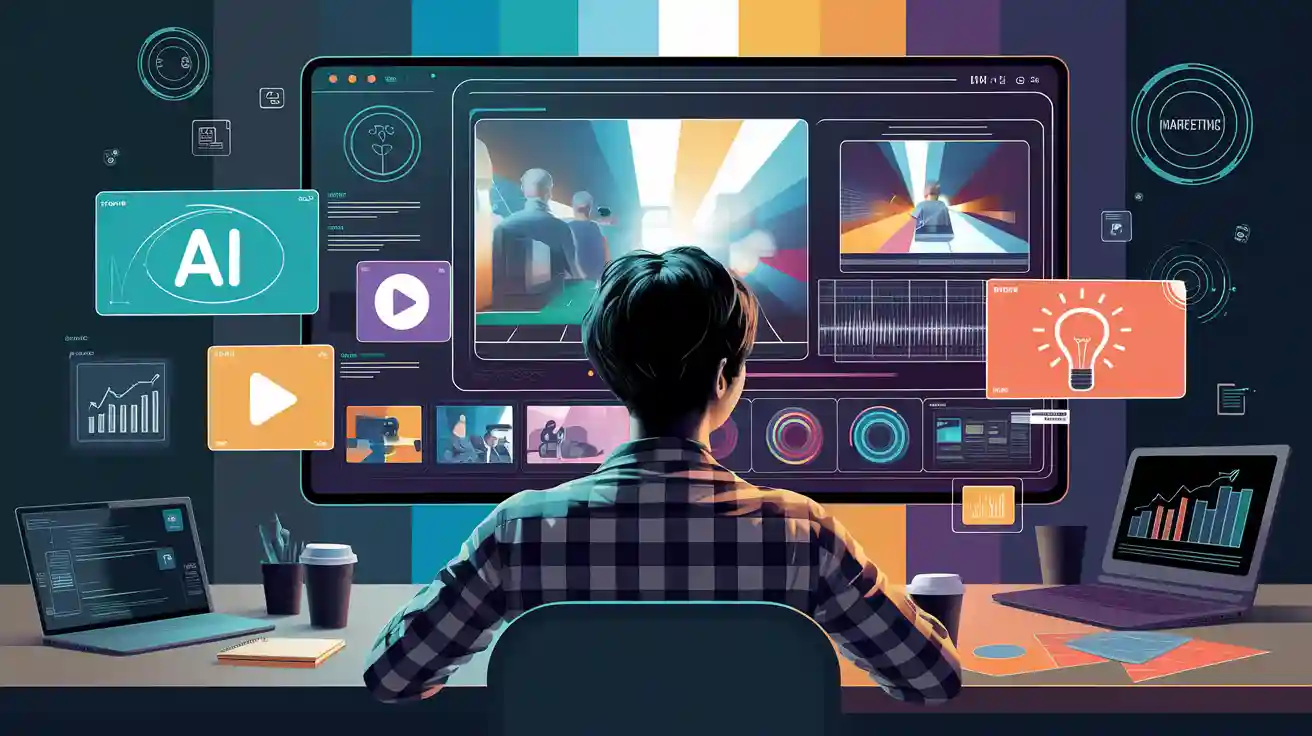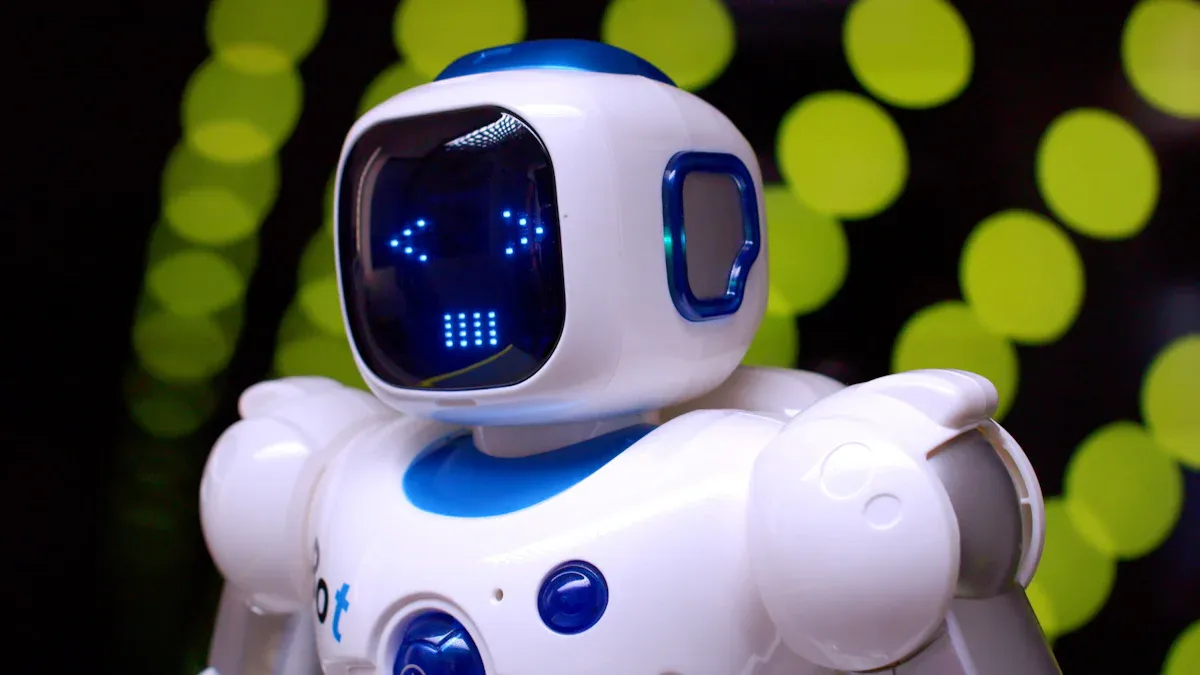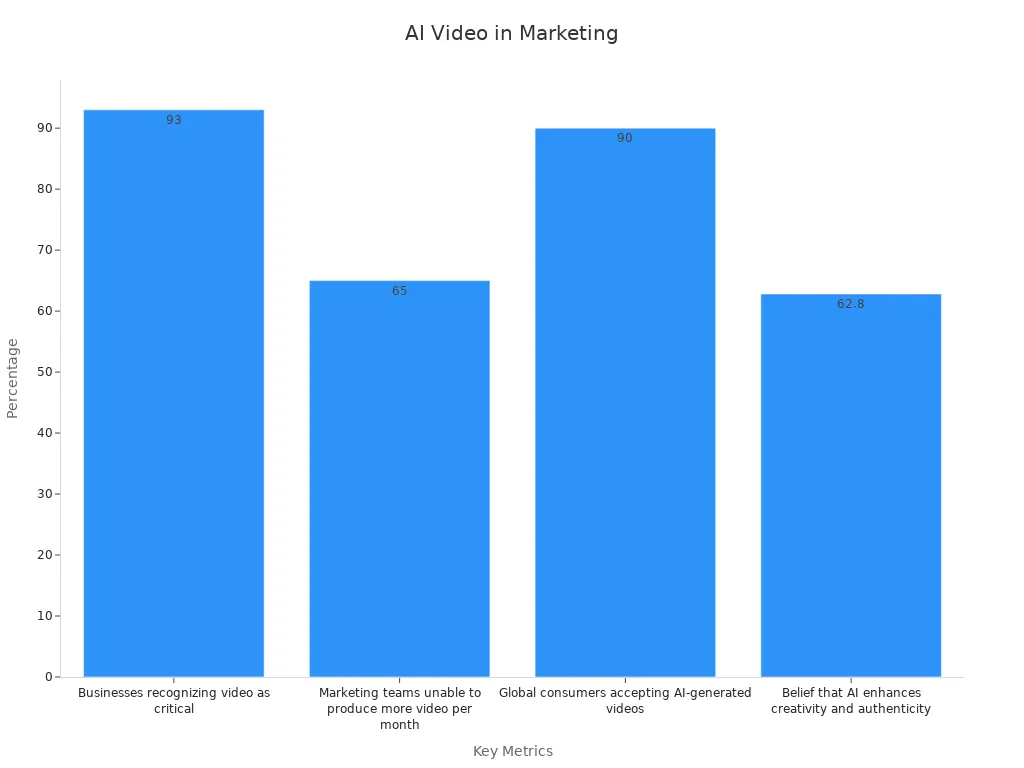
Imagine creating stunning marketing videos in minutes without hiring a full production team. That’s the magic of AI video generation! It’s changing the game for marketers like you by saving time, reducing costs, and delivering results faster. Did you know that 83% of marketers using AI report increased productivity? Or that AI saves them over five hours every week? It’s no surprise that nearly 75% of marketers feel AI gives them a competitive edge. Whether you’re aiming for personalization or speed, AI video tools can help you achieve your goals while staying ahead of the curve.
Key Takeaways
-
AI video tools save time and cut costs. Marketers can make great videos fast.
-
AI-made personalized videos can increase audience interest and trust.
-
Using AI tools in your work makes video creation easier and faster.
-
Tracking video success with key numbers helps improve results and profits.
-
Begin small by trying one AI video tool to see its effect before doing more.
Understanding AI Video Generation
What is AI video generation?
AI video generation is the process of creating videos using artificial intelligence technologies. Instead of relying on traditional methods that require a full production team, AI tools handle tasks like scripting, editing, and even voiceovers. These tools use advanced technologies such as Natural Language Processing (NLP) to understand text and turn it into visual content. For example, NLP can generate natural-sounding scripts and voiceovers, making your videos feel more human. AI also uses neural networks to recognize patterns and create realistic visuals. Some tools even rely on Generative Adversarial Networks (GANs) to produce high-quality images and videos. In short, AI video generation simplifies video creation while maintaining professional quality.
How does AI video generation work?
AI video generation works by combining several technologies to automate the video creation process. First, it uses NLP to analyze your text input and match it with relevant visuals. If you need a voiceover, Text-to-Speech (TTS) technology converts your text into lifelike speech. Neural networks play a key role in identifying patterns and generating visuals, while GANs ensure the final output looks polished and realistic. Some tools also incorporate 3D modeling to create interactive and immersive videos. All these technologies work together to transform your ideas into engaging video content with minimal effort on your part.
Why is AI video generation important for marketing?
AI video generation is a game-changer for marketing. It reduces the need for expensive resources and manual labor, making video production more affordable. You can also create personalized videos by analyzing customer data, which leads to higher engagement. AI tools allow you to scale your video production without sacrificing quality, so you can target different market segments effectively. Did you know that 73% of Gen X consumers are more likely to increase video content output with AI tools? This shows how AI can help you stay competitive. Plus, by cutting production costs, AI improves your return on investment, making video marketing a smarter choice for your business.
Benefits of AI Video Generation in Marketing

Cost efficiency and scalability
Creating videos the traditional way can be expensive and time-consuming. You might spend as much as $1,800 per minute on production, which makes it tough to create content regularly. AI video generation changes the game by slashing costs and boosting scalability. With AI tools, you can produce 5–10 times more videos using the same budget. Imagine the possibilities—multiple videos tailored for different audiences and platforms without breaking the bank.
Instead of investing $10,000 or more in a single video, you can create a library of content that resonates with your audience. Plus, AI-generated videos often lead to a 20-30% increase in conversion rates. That means better results for less money. And when you consider the 3-5x better ROI, it’s clear that AI video generation isn’t just cost-effective—it’s a smart investment for growth.
Enhanced personalization and audience targeting
Have you ever wished you could speak directly to your audience? AI video generation makes that possible. These tools analyze viewer preferences and create highly personalized content. Whether it’s addressing someone by name or tailoring the message to their interests, AI helps you connect on a deeper level.
Personalized videos don’t just grab attention—they keep it. Studies show that personalization boosts engagement and builds loyalty. In fact, McKinsey found that effective personalization can increase revenue by 10-15%. When your audience feels understood, they’re more likely to trust your brand and stick around. AI video tools make this level of customization easy, helping you deliver the right message to the right person at the right time.
Faster production cycles and improved efficiency
Speed matters in marketing. Traditional video production can take weeks, but AI video generation cuts that time in half. Tools powered by AI streamline the entire process, from scripting to editing. HubSpot reports that AI can reduce production time by 50%, allowing you to create content faster than ever.
This efficiency doesn’t just save time—it boosts productivity. You can track how many videos you produce each month and see the difference AI makes. With faster production cycles, you can respond to trends, launch campaigns quickly, and stay ahead of the competition. AI video generation empowers you to do more in less time, without sacrificing quality.
Steps to Integrate AI Video Generation into Your Marketing Strategy
Identify your marketing goals
Before diving into AI video generation, you need to define your marketing goals. What do you want to achieve with your videos? Are you looking to boost brand awareness, drive website traffic, or increase conversions? Clear goals will guide your strategy and help you measure success.
Think about your audience. What kind of content resonates with them? For example, if your target audience prefers educational content, you might focus on creating explainer videos. If they enjoy entertainment, short, engaging clips could work better. Knowing your audience ensures your videos hit the mark.
Here’s why this step matters: 93% of businesses recognize video as critical to their marketing strategies. Yet, 65% of marketing teams struggle to produce more than one video per month. By setting clear goals, you can prioritize your efforts and make the most of AI tools.
Tip: Write down your goals and align them with your overall marketing strategy. This will keep your efforts focused and effective.
Choose the right AI video tools
Not all AI video tools are created equal. Choosing the right one depends on your needs and goals. Do you want to turn blog posts into videos? Or maybe you need tools for creating personalized content? Understanding the different types of AI video tools can help you make the best choice.
Here’s a quick comparison of popular AI video tools:
|
Type of AI Video Tool |
Description |
Use Case |
|---|---|---|
|
Converts written content into engaging videos with images and music. |
Ideal for video summaries or promotional content. |
|
|
Image-to-Video |
Animates still images into lively presentations. |
Great for social media posts or portfolios. |
|
Full Video Generation Tools |
Offers extensive editing and personalization options. |
Suitable for tailored video content creation. |
If you’re unsure where to start, look for tools with user-friendly interfaces and strong customer reviews. Many platforms offer free trials, so you can test them before committing. Remember, 90% of global consumers are open to AI-generated videos, so the right tool can help you meet this growing demand.
Pro Tip: Start small. Experiment with one type of tool, like text-to-video, before expanding to more advanced options.
Incorporate AI into your workflow
Once you’ve chosen your tools, it’s time to integrate AI into your workflow. Start by identifying repetitive tasks that AI can handle. For instance, AI can automate scriptwriting, video editing, and even voiceovers. This frees up your team to focus on creative tasks.
Here’s how you can streamline your workflow with AI:
-
Plan your content: Use AI to analyze trends and identify topics your audience cares about.
-
Create videos: Let AI handle the heavy lifting, from generating visuals to adding music.
-
Distribute content: Use AI-powered platforms to schedule and share your videos across multiple channels.
Efficiency is key. AI can reduce production time by 50%, allowing you to create more content in less time. Plus, 62.8% of people believe AI enhances creativity and authenticity. By incorporating AI into your workflow, you can produce high-quality videos that resonate with your audience.

Note: Regularly review your workflow to identify new opportunities for AI integration. This ensures you’re always improving and staying ahead of the competition.
Measure performance and optimize
Once your AI-generated videos are live, the next step is to measure their performance. Tracking the right metrics helps you understand what’s working and what needs improvement. By analyzing the data, you can optimize your campaigns for better results. Let’s break it down.
Key Metrics to Track
To evaluate the success of your AI video campaigns, focus on these essential metrics:
-
View Count: This shows how many times your video has been watched. It’s a great way to measure the reach of your content across platforms.
-
Play Rate: This metric tells you the percentage of visitors who clicked play on your video. A high play rate means your video is grabbing attention.
-
Engagement: Engagement reflects how much of your video viewers watched on average. It’s a strong indicator of how compelling your content is.
Here’s a quick overview of additional metrics to consider:
|
Metric |
Description |
|---|---|
|
Video Views |
Indicates the amount of attention your content is receiving and highlights effective formats. |
|
Measures active interactions, providing a stronger indicator of content effectiveness. |
|
|
Conversion Metrics |
Includes traffic, clicks, and CTR, showing how well videos drive business results. |
|
Top and Bottom Videos |
Analyzes performance across platforms to identify successful formats and avoid ineffective content. |
Tip: Use these metrics to identify trends. For example, if one video has a higher engagement rate, analyze what made it stand out and replicate that success in future campaigns.
Leverage AI for Advanced Analytics
AI tools can take your performance measurement to the next level. They provide real-time analytics, tracking viewer engagement, drop-off rates, and interaction patterns. This means you can see how your audience interacts with your videos as it happens.
Here are some advanced techniques you can use:
-
Real-Time Analytics: Get up-to-date insights into how your videos are performing.
-
Attribution Modeling: Understand which marketing touchpoints drive conversions.
-
Predictive Metrics: Use historical data to forecast future performance.
-
A/B Testing: Experiment with different video styles or messages to find what resonates most with your audience.
Did you know? 75% of marketers using AI for video analytics report improved decision-making and better campaign performance. By relying on data-driven insights, you can make smarter choices and achieve your goals faster.
Optimize for Better Results
Once you’ve analyzed the data, it’s time to optimize. Start by identifying areas where your videos can improve. For instance, if your engagement rate is low, consider shortening your videos or making the first few seconds more captivating.
Here’s a simple optimization checklist:
-
Refine Your Content: Focus on creating videos that align with your audience’s preferences.
-
Test Different Formats: Use A/B testing to compare different styles, lengths, or messages.
-
Improve Distribution: Share your videos on platforms where your audience is most active.
-
Monitor Trends: Keep an eye on what’s trending in your industry and adapt your content accordingly.
Pro Tip: Optimization is an ongoing process. Regularly review your metrics and make adjustments to stay ahead of the competition.
By measuring performance and optimizing your strategy, you can ensure your AI video campaigns deliver maximum impact. Remember, the key is to stay flexible and let the data guide your decisions. With the right approach, you’ll see better engagement, higher conversions, and a stronger ROI.
Real-World Examples of AI Video Generation in Marketing

Case studies of successful implementation
Let’s look at how businesses are already using AI video generation to achieve incredible results. Take Synthesia, for example. A global e-learning company used this tool to create training videos in multiple languages. Instead of hiring actors and translators, they relied on AI to generate lifelike avatars and voiceovers. The result? They cut production time by 80% and saved thousands of dollars.
Another great example is Pictory. A small marketing agency used this platform to turn blog posts into engaging videos. They didn’t need a video editor or a big budget. With AI, they created professional-looking content in minutes. Their client engagement skyrocketed, and they landed more contracts.
These case studies show how AI video generation can transform your workflow. Whether you’re a large corporation or a small business, the potential is huge.
Examples of brands leveraging AI video tools
Big brands are also jumping on the AI video bandwagon. Coca-Cola, for instance, used AI to create personalized video ads. Each ad addressed viewers by name and included tailored messages based on their preferences. This approach boosted their engagement rates and strengthened customer loyalty.
Another example is Nike. They used AI to produce short, dynamic videos for social media. These videos showcased their products in action, appealing to younger audiences. The campaign went viral, proving that AI can help brands connect with their target market.
Even smaller brands are seeing success. A local fitness studio used AI tools to create promotional videos for Instagram. They didn’t have a big budget, but AI made it possible to compete with larger gyms.
These examples highlight the versatility of AI video tools. Whether you’re creating ads, tutorials, or social media content, AI can help you stand out.
Challenges and Solutions in AI Video Generation
Addressing data privacy and ethical concerns
AI video generation comes with its share of challenges, especially when it comes to data privacy and ethics. You might wonder, “How do I ensure my videos comply with regulations?” Well, laws like GDPR impose strict rules. Non-compliance can lead to fines of up to €20 million or 4% of your global turnover. That’s a hefty price to pay!
Here’s a quick look at some key concerns:
|
Evidence Type |
Description |
|---|---|
|
Compliance Statistics |
GDPR allows fines up to €20 million or 4% of global turnover for non-compliance. |
|
Case Study |
A deepfake video misrepresented a public figure, highlighting privacy violations and misinformation risks. |
|
Adoption Rate |
72% increase in machine learning pipeline adoption for generative AI strategies. |
To tackle these issues, always prioritize transparency. Let your audience know how their data is being used. Use AI tools that follow strict compliance standards. And don’t forget to monitor your content for ethical concerns, like avoiding deepfakes or misleading visuals.
Overcoming technical barriers
AI video tools are powerful, but they’re not perfect. You might face challenges like limited customization options or compatibility issues with your existing systems. These barriers can slow you down and make the process frustrating.
To overcome them, start by choosing tools that integrate seamlessly with your workflow. Look for platforms offering robust customer support and regular updates. If you’re dealing with technical glitches, don’t hesitate to reach out to the tool’s support team. Many companies provide tutorials and troubleshooting guides to help you get back on track quickly.
Ensuring content quality and authenticity
You want your videos to look professional and feel authentic, right? That’s where quality assurance measures come in. AI tools now use advanced metrics to ensure your content meets high standards.
Here are some key metrics to know:
-
CLIP score: Matches visuals with text descriptions for better alignment.
-
FID (Fréchet Inception Distance): Compares generated visuals to real ones for quality checks.
-
HPS (Human Preference Score): Evaluates content based on human preferences.
-
ImageReward: Assesses realism, text alignment, and safety.
By leveraging these metrics, you can ensure your videos resonate with your audience. Regularly review your content and make adjustments as needed. Authenticity builds trust, and trust keeps your audience coming back for more.
AI video generation is revolutionizing marketing. It saves time, cuts costs, and helps you create personalized, engaging content at scale. By following the steps outlined—defining your goals, choosing the right tools, integrating AI into your workflow, and measuring performance—you can unlock its full potential.
Tip: Start small. Experiment with one AI tool and track its impact before scaling up.
Don’t wait to explore these tools. The sooner you adopt AI, the faster you’ll gain a competitive edge. Stay curious, keep learning, and let AI transform your marketing strategy.
FAQ
What types of videos can I create with AI video tools?
AI tools let you create various videos, including explainer videos, product demos, personalized ads, and social media content. You can even turn blog posts into videos or animate still images. The possibilities are endless, and the tools adapt to your needs.
Do I need technical skills to use AI video tools?
Not at all! Most AI video tools are user-friendly and designed for beginners. They offer drag-and-drop interfaces, templates, and tutorials. You can create professional videos without prior experience or technical knowledge.
How can AI video generation improve my ROI?
AI reduces production costs and speeds up video creation. It also enables personalized content, which boosts engagement and conversions. By reaching your audience effectively and efficiently, you’ll see a stronger return on investment.
Tip: Track metrics like engagement and conversion rates to measure your ROI improvements.
Are AI-generated videos suitable for all industries?
Yes! AI video tools work for industries like retail, education, healthcare, and more. Whether you’re promoting products, training employees, or sharing updates, AI-generated videos can fit your goals.
How do I ensure my AI videos are high quality?
Choose reputable AI tools with advanced features like text alignment and visual quality checks. Regularly review your content for authenticity and relevance. Testing different formats and styles can also help you refine your videos.
Pro Tip: Use metrics like engagement rates to identify what resonates with your audience.
